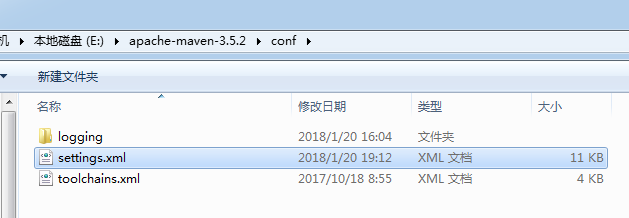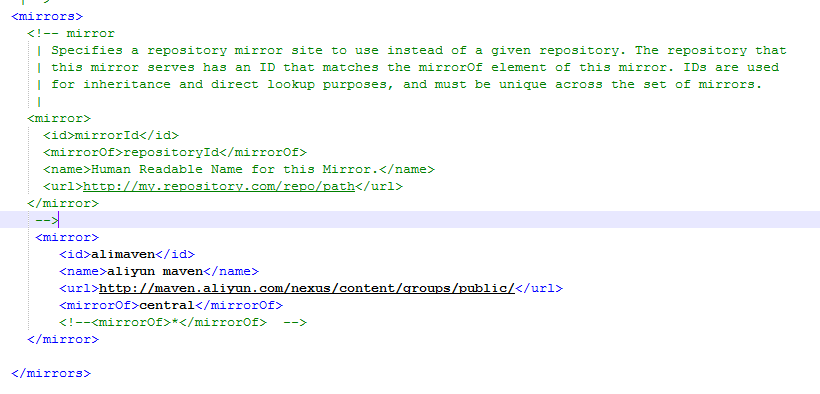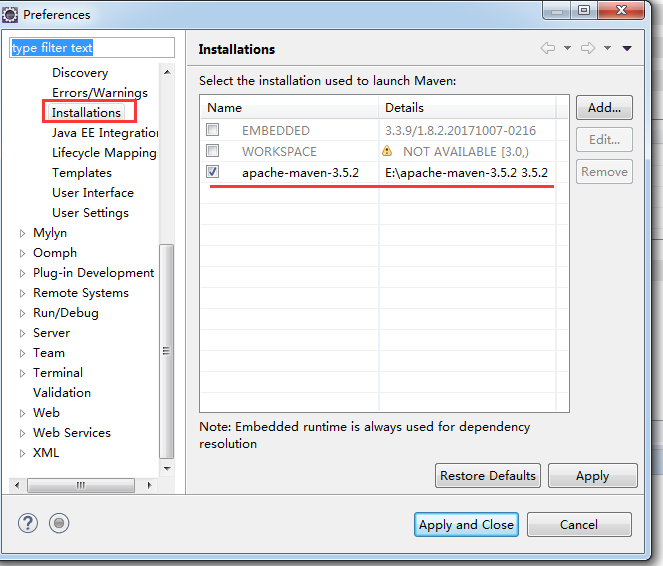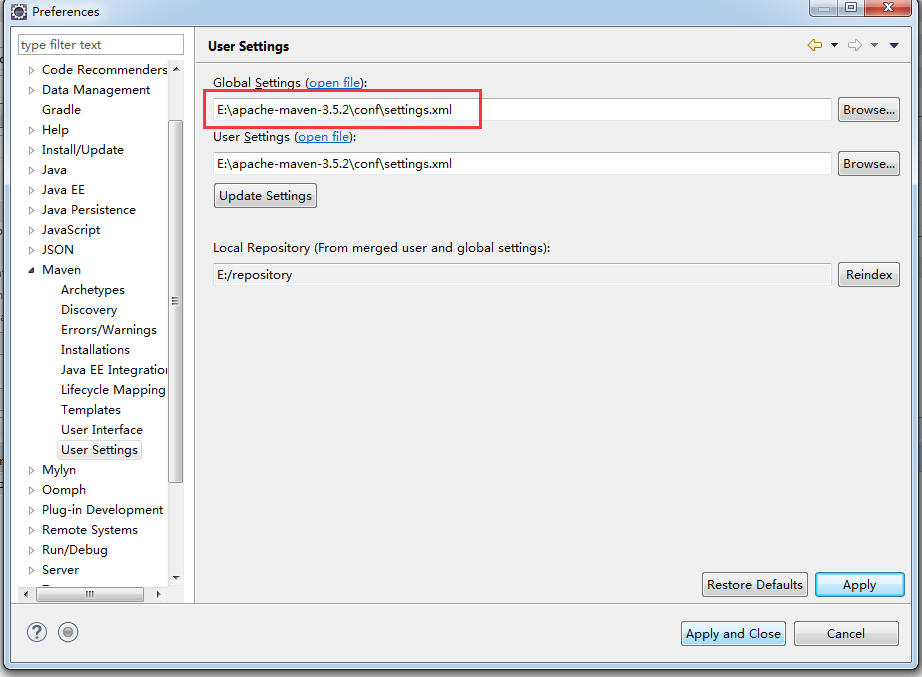Eclipse中Maven的本地仓库引导配置
简单整理一下,方便理解操作。
1、本地拷贝maven文件后,打开maven中的.setting 文件:

2、配置文件:
<?xml version="1.0" encoding="UTF-8"?> <!--
Licensed to the Apache Software Foundation (ASF) under one
or more contributor license agreements. See the NOTICE file
distributed with this work for additional information
regarding copyright ownership. The ASF licenses this file
to you under the Apache License, Version 2.0 (the
"License"); you may not use this file except in compliance
with the License. You may obtain a copy of the License at http://www.apache.org/licenses/LICENSE-2.0 Unless required by applicable law or agreed to in writing,
software distributed under the License is distributed on an
"AS IS" BASIS, WITHOUT WARRANTIES OR CONDITIONS OF ANY
KIND, either express or implied. See the License for the
specific language governing permissions and limitations
under the License.
--> <!--
| This is the configuration file for Maven. It can be specified at two levels:
|
| 1. User Level. This settings.xml file provides configuration for a single user,
| and is normally provided in ${user.home}/.m2/settings.xml.
|
| NOTE: This location can be overridden with the CLI option:
|
| -s /path/to/user/settings.xml
|
| 2. Global Level. This settings.xml file provides configuration for all Maven
| users on a machine (assuming they're all using the same Maven
| installation). It's normally provided in
| ${maven.conf}/settings.xml.
|
| NOTE: This location can be overridden with the CLI option:
|
| -gs /path/to/global/settings.xml
|
| The sections in this sample file are intended to give you a running start at
| getting the most out of your Maven installation. Where appropriate, the default
| values (values used when the setting is not specified) are provided.
|
|-->
<settings xmlns="http://maven.apache.org/SETTINGS/1.0.0"
xmlns:xsi="http://www.w3.org/2001/XMLSchema-instance"
xsi:schemaLocation="http://maven.apache.org/SETTINGS/1.0.0 http://maven.apache.org/xsd/settings-1.0.0.xsd">
<!-- localRepository
| The path to the local repository maven will use to store artifacts.
|
| Default: ${user.home}/.m2/repository -->
<localRepository>E:/repository</localRepository> <!-- interactiveMode
| This will determine whether maven prompts you when it needs input. If set to false,
| maven will use a sensible default value, perhaps based on some other setting, for
| the parameter in question.
|
| Default: true
<interactiveMode>true</interactiveMode>
--> <!-- offline
| Determines whether maven should attempt to connect to the network when executing a build.
| This will have an effect on artifact downloads, artifact deployment, and others.
|
| Default: false
<offline>false</offline>
--> <!-- pluginGroups
| This is a list of additional group identifiers that will be searched when resolving plugins by their prefix, i.e.
| when invoking a command line like "mvn prefix:goal". Maven will automatically add the group identifiers
| "org.apache.maven.plugins" and "org.codehaus.mojo" if these are not already contained in the list.
|-->
<pluginGroups>
<!-- pluginGroup
| Specifies a further group identifier to use for plugin lookup.
<pluginGroup>com.your.plugins</pluginGroup>
-->
</pluginGroups> <!-- proxies
| This is a list of proxies which can be used on this machine to connect to the network.
| Unless otherwise specified (by system property or command-line switch), the first proxy
| specification in this list marked as active will be used.
|-->
<proxies>
<!-- proxy
| Specification for one proxy, to be used in connecting to the network.
|
<proxy>
<id>optional</id>
<active>true</active>
<protocol>http</protocol>
<username>proxyuser</username>
<password>proxypass</password>
<host>proxy.host.net</host>
<port>80</port>
<nonProxyHosts>local.net|some.host.com</nonProxyHosts>
</proxy>
-->
</proxies> <!-- servers
| This is a list of authentication profiles, keyed by the server-id used within the system.
| Authentication profiles can be used whenever maven must make a connection to a remote server.
|-->
<servers>
<!-- server
| Specifies the authentication information to use when connecting to a particular server, identified by
| a unique name within the system (referred to by the 'id' attribute below).
|
| NOTE: You should either specify username/password OR privateKey/passphrase, since these pairings are
| used together.
|
<server>
<id>deploymentRepo</id>
<username>repouser</username>
<password>repopwd</password>
</server>
--> <!-- Another sample, using keys to authenticate.
<server>
<id>siteServer</id>
<privateKey>/path/to/private/key</privateKey>
<passphrase>optional; leave empty if not used.</passphrase>
</server>
-->
</servers> <!-- mirrors
| This is a list of mirrors to be used in downloading artifacts from remote repositories.
|
| It works like this: a POM may declare a repository to use in resolving certain artifacts.
| However, this repository may have problems with heavy traffic at times, so people have mirrored
| it to several places.
|
| That repository definition will have a unique id, so we can create a mirror reference for that
| repository, to be used as an alternate download site. The mirror site will be the preferred
| server for that repository.
|-->
<mirrors>
<!-- mirror
| Specifies a repository mirror site to use instead of a given repository. The repository that
| this mirror serves has an ID that matches the mirrorOf element of this mirror. IDs are used
| for inheritance and direct lookup purposes, and must be unique across the set of mirrors.
|
<mirror>
<id>mirrorId</id>
<mirrorOf>repositoryId</mirrorOf>
<name>Human Readable Name for this Mirror.</name>
<url>http://my.repository.com/repo/path</url>
</mirror>
-->
<!--<mirror>
<id>alimaven</id>
<name>aliyun maven</name>
<url>http://maven.aliyun.com/nexus/content/groups/public/</url>
//<mirrorOf>central</mirrorOf>
<mirrorOf>*</mirrorOf>
</mirror>--> </mirrors> <!-- profiles
| This is a list of profiles which can be activated in a variety of ways, and which can modify
| the build process. Profiles provided in the settings.xml are intended to provide local machine-
| specific paths and repository locations which allow the build to work in the local environment.
|
| For example, if you have an integration testing plugin - like cactus - that needs to know where
| your Tomcat instance is installed, you can provide a variable here such that the variable is
| dereferenced during the build process to configure the cactus plugin.
|
| As noted above, profiles can be activated in a variety of ways. One way - the activeProfiles
| section of this document (settings.xml) - will be discussed later. Another way essentially
| relies on the detection of a system property, either matching a particular value for the property,
| or merely testing its existence. Profiles can also be activated by JDK version prefix, where a
| value of '1.4' might activate a profile when the build is executed on a JDK version of '1.4.2_07'.
| Finally, the list of active profiles can be specified directly from the command line.
|
| NOTE: For profiles defined in the settings.xml, you are restricted to specifying only artifact
| repositories, plugin repositories, and free-form properties to be used as configuration
| variables for plugins in the POM.
|
|-->
<profiles>
<!--
<id>jdk17</id>
<activation>
<activeByDefault>true</activeByDefault>
<jdk>1.7</jdk>
</activation>
<properties>
<maven.compiler.source>1.7</maven.compiler.source>
<maven.compiler.target>1.7</maven.compiler.target>
<maven.compiler.compilerVersion>1.7</maven.compiler.compilerVersion>
</properties> -->
<!-- profile
| Specifies a set of introductions to the build process, to be activated using one or more of the
| mechanisms described above. For inheritance purposes, and to activate profiles via <activatedProfiles/>
| or the command line, profiles have to have an ID that is unique.
|
| An encouraged best practice for profile identification is to use a consistent naming convention
| for profiles, such as 'env-dev', 'env-test', 'env-production', 'user-jdcasey', 'user-brett', etc.
| This will make it more intuitive to understand what the set of introduced profiles is attempting
| to accomplish, particularly when you only have a list of profile id's for debug.
|
| This profile example uses the JDK version to trigger activation, and provides a JDK-specific repo.
<profile>
<id>jdk-1.4</id> <activation>
<jdk>1.4</jdk>
</activation> <repositories>
<repository>
<id>jdk14</id>
<name>Repository for JDK 1.4 builds</name>
<url>http://www.myhost.com/maven/jdk14</url>
<layout>default</layout>
<snapshotPolicy>always</snapshotPolicy>
</repository>
</repositories>
</profile>
--> <!--
| Here is another profile, activated by the system property 'target-env' with a value of 'dev',
| which provides a specific path to the Tomcat instance. To use this, your plugin configuration
| might hypothetically look like:
|
| ...
| <plugin>
| <groupId>org.myco.myplugins</groupId>
| <artifactId>myplugin</artifactId>
|
| <configuration>
| <tomcatLocation>${tomcatPath}</tomcatLocation>
| </configuration>
| </plugin>
| ...
|
| NOTE: If you just wanted to inject this configuration whenever someone set 'target-env' to
| anything, you could just leave off the <value/> inside the activation-property.
|
<profile>
<id>env-dev</id> <activation>
<property>
<name>target-env</name>
<value>dev</value>
</property>
</activation> <properties>
<tomcatPath>/path/to/tomcat/instance</tomcatPath>
</properties>
</profile>
-->
</profiles> <!-- activeProfiles
| List of profiles that are active for all builds.
|
<activeProfiles>
<activeProfile>alwaysActiveProfile</activeProfile>
<activeProfile>anotherAlwaysActiveProfile</activeProfile>
</activeProfiles>
-->
</settings>
其中两个位置需要注意:本地仓库路径和阿里云maven镜像配置(增加jar包下载速度)


3、Eclipse中配置maven及刚才配置的settings文件。


保存即可。
Eclipse中Maven的本地仓库引导配置的更多相关文章
- eclipse中maven项目jar包不会自动下载解决办法
Eclipse中maven从远程仓库中下载jar包有时会很慢,有些甚至进度停止不动,这个时候我们可能会终止当前下载,但是终止jar包下载后会出现一个问题,再次打开Eclipse时,你会发现提示你项目中 ...
- eclipse中maven插件,改变默认仓库位置
一.eclipse中maven默认仓库是当前用户下.m2/repository,需改变默认路径按照下面步骤. 步骤一:安装maven 下载:http://maven.apache.org/ 配置mav ...
- bat批处理文件启动Eclipse和ivy本地仓库的配置
一.bat批处理文件启动Eclipse 所需文件: 1.eclipse 2.jre 3.startup-eclipse.bat 确保以上三个文件夹同级 startup-eclipse.bat: set ...
- eclipse 如何修改maven插件本地仓库jar包默认存储位置
eclipse 如何修改maven插件本地仓库jar包默认存储位置 CreateTime--2018年4月18日11:04:47 Author:Marydon 1.更改eclipse的maven本 ...
- (一)maven之——maven基础及本地仓库的配置
一.初步了解maven Apache Maven是一个软件项目管理的综合工具.基于项目对象模型(POM)的概念,提供了帮助管理构建.文档.报告.依赖.发布等方法,Maven简化和标准化项目建设过程.处 ...
- maven下载,安装与eclipse中maven配置
1.maven下载.安装与环境变量配置 http://blog.csdn.net/jiuqiyuliang/article/details/45390313 2.Eclipse中maven的配置 ht ...
- Eclipse中Maven的配置
Maven 的配置 1. 安装配置Maven: 1.1 从Apache网站 http://maven.apache.org/ 下载并且解压缩安装Apache Maven 1.2 配置 Maven 的c ...
- eclipse中maven本地库和远程阿里库的配置
很久没有写博客了,最近比较闲将最近学的和遇到的问题做一个备忘 1.eclipse中maven本地库的配置 如果只是下载和安装了maven没有指定maven本地库的位置,maven的默认的本地库在c:/ ...
- K.O. -------- Eclipse中Maven的报错处理
----------------------siwuxie095 K.O. -------- Eclipse 中 Maven 的报错处理 ...
随机推荐
- Mysql 命令详解
1.读取服务器变量: show [global|session] variables;2.更改非静态(只读)变量: set [global|session] <variable_na ...
- LDA(Latent Dirichlet allocation)主题模型
LDA是一种典型的词袋模型,即它认为一篇文档是由一组词构成的一个集合,词与词之间没有顺序以及先后的关系.一篇文档可以包含多个主题,文档中每一个词都由其中的一个主题生成. 它是一种主题模型,它可以将文档 ...
- Kafka简介、安装
一.Kafka简介 Kafka是一个分布式.可分区的.可复制的消息系统.几个基本的消息系统术语:1.消费者(Consumer):从消息队列(Kafka)中请求消息的客户端应用程序.2.生产者(Prod ...
- djange数据库优化操作
一.all()命令分析 1.user_list = models.UserInfo.objects.all() #查询表一次可以得到该表的所有信息 注释:user_list.query可以查询到 ...
- 所有文本的 attributes 枚举,NSAttributedString
// Predefined character attributes for text. If the key is not in the dictionary, then use the defau ...
- 【鸟哥的Linux私房菜】笔记3
正确地开机 最好不要使用root账号登陆!GNOME图形界面 View items as a list X WindowShell 文本交互界面bash是Shell的名称,Linux的默认壳程序就是b ...
- Vue全家桶 vue + vue-router + vuex
Vue实例的生命周期钩子函数(8个) 1. beforeCreate data属性光声明没有赋值的时候 2. created ...
- 20165101刘天野 2017-2018-2 《Java程序设计》第3周学习总结
20165101刘天野 2017-2018-2 <Java程序设计>第3周学习总结 编程语言的几个发展阶段 类 构造方法与对象的创建 类与程序的基本结构 参数传值 对象的组合 实例成员与类 ...
- SQL性能调优策略
1.建立索引 2.避免全表扫描 避免使用is null, is not null,这样写会放弃该字段的索引. 如果会出现这种情况,尽量在设计表的时候设置默认值 比较操作符中!= <>等避免 ...
- OC_id类型
博客正式开通啦!以后会每天为大家更新知识,将过去学习的笔记发布出来.供大家学习交流. 在Objective-C 中,id 类型是一个独特的数据类型.在概念上,类似Java 的Object 类,可以转 ...
